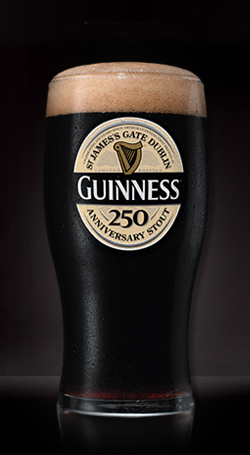
This year marks the 250th anniversary for Guinness. To celebrate this occasion, they will be launching a Special Edition Guinness 250 Anniversary Stout on April 24th.
“Using a unique brewhouse process that combines the use of stout and ale malt, it’s a distinctive carbonated stout with a clean, smooth finish. This is especially exciting, as we haven’t introduced a new stout to the US since 1967, when we first started importing Guinness Draught.”
It’s only available for a limited time.
Important points in Guinness History:
1725 - Birth of a legend: Arthur, son of Richard and Elizabeth Guinness is born in Celbridge, County Kildare, Ireland.
1752 - Blessed inheritance: Arthur Guinness is left £100 in the will of Archbishop Price. Three years later he sets up business as a brewer in Leixlip, County Kildare, just 17km from Dublin.
1759 - Signing: Arthur Guinness signs a 9,000-year lease on a disused brewery at St. James’s Gate, Dublin. It costs him an initial £100 with an annual rent of £45 – this crucially includes water rights. The brewery covers four acres and consists of a copper, a kieve, a mill, two malthouses, stabling for 12 horses and a loft to hold 200 tons of hay. Arthur begins brewing porter and ale.
1769 - Genius exported for the first time: The first export shipment of six and a half barrels of GUINNESS beer leaves Dublin on a sailing vessel bound for England.
1775 - Troubled waters: On 16th May a Dublin Corporation committee & sheriff are sent to cut off and fill in the channel from which the Brewery draws its water. Arthur Guinness is forced to brandish a pickaxe to protect his supply. The dispute is finally settled in 1784 when water rights are granted for 8,975 years.
1803 - Arthur Guinness dies: Raise a glass to the memory of a true original. His son, Arthur Guinness II, inherits the brewing mantle.
1821 - Secrets of a perfect porter: Arthur Guinness II sets down precise instructions for brewing GUINNESS Extra Superior Porter – the precursor to today’s GUINNESS Original and GUINNESS Extra Stout.
1834 - New bottles have clear advantage: The Glass Tax is repealed and GUINNESS can now be bottled in glass rather than stoneware.
1850s - From father to son to grandson: Sir Benjamin Lee Guinness, son of Arthur Guinness II, takes over the brewery on the death of his father. Sir Benjamin Lee becomes a Member of Parliament for Dublin City and also serves as Lord Mayor of Dublin.
1862 - The Harp plays its first bars: The trademark beer label is introduced - a buff oval label with the harp and Arthur Guinness’ signature. The Harp is registered as a trademark in 1876.
1914 - Brewery output is up to almost 3 million barrels.
1976 - Over 7 million glasses of Guinness are drowned daily.
1985 - Guinness now sold in 120 countries and brewed in 25.
1997 - Diageo is formed: Guinness PLC & Grand Metropolitan PLC merge to form Diageo PLC. The name comes from the Latin word for ‘day’ and the Greek word for ‘world’.
2001 - World drinks two billion pints: Almost 2 billion pints of GUINNESS a year were sold around the world and over 1 million pints of GUINNESS a day were sold in Great Britain alone.
2007 - 10 Million glasses of GUINNESS are enjoyed every day: GUINNESS is sold in over 150 countries around the world.http://www.2beerguys.com/blog/category/beer/new-release-beer/

